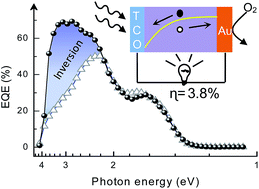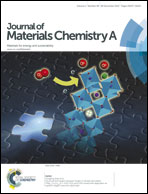Inverted Schottky quantum dot solar cells with enhanced carrier extraction and air-stability†
Abstract
We introduce a novel colloidal quantum dot solar cell (CQD SC) architecture, defined as inverted Schottky CQD SCs, which consists of a thin film of PbS CQDs sandwiched between a low-work-function, transparent conducting oxide (Lϕ-TCO) and a high-work-function metal anode. On Lϕ-TCO substrates, which were generated by coating a thin layer of polyethylenimine (PEI) onto FTO, a series of inverted Schottky CQD SCs with varied PbS CQD sizes and QD layer thicknesses were fabricated and characterized using capacitance–voltage (C–V), current–voltage (J–V), and external quantum efficiency (EQE). A Schottky junction, of about 180 nm in width, was formed at the front TCO contact, resulting in an EQE of approximately 70% in the short-wavelength region. The champion device reached 3.8% AM1.5 in power conversion efficiency, and retained efficiency over several weeks of air-exposure. A record open-circuit voltage (VOC) of 0.75 V was achieved by employing PbS CQDs of 1.56 eV in the bandgap. Advantages including the simple device structure, efficient carrier extraction, and air-stability demonstrated in this study suggest that inverted Schottky CQD SCs can reduce the price per Watt ratio and facilitate the development of CQD tandem solar cells.


 Please wait while we load your content...
Please wait while we load your content...